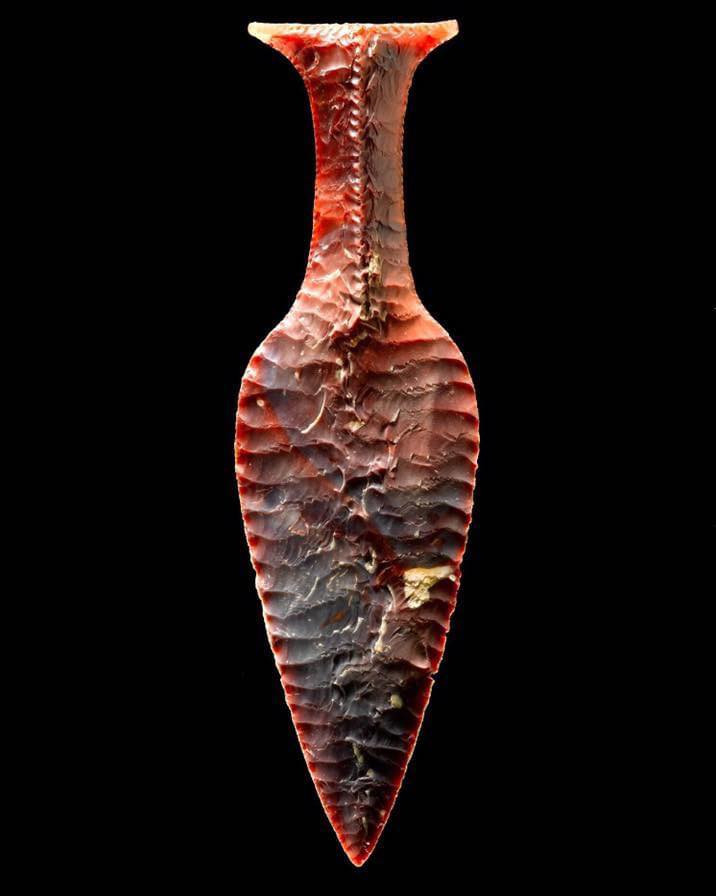In 1867, on the serene and picturesque Danish island of Fænø, the joyful shout of a young boy echoed across a quiet field: “Look, mum, what a beautiful stone!” At that moment, neither he nor his mother could have imagined the true significance of what he had found. This wasn’t just a curious stone—it was the Hindsgavl Dagger, one of the most extraordinary artifacts ever uncovered from the Nordic Stone Age. This chance discovery would not only captivate archaeologists and historians for generations but also come to symbolize the artistic brilliance and cultural identity of early Scandinavian societies.

The remarkable journey of the Hindsgavl Dagger, from a chance find in a rural field to a celebrated national treasure, began to take shape in 1889. That year, the dagger was presented at the prestigious Exposition Universelle in Paris, a world fair that drew attention to the finest achievements in art, science, and culture from around the globe. Amidst the dazzling displays of human ingenuity, the Hindsgavl Dagger stood out. Its stunning craftsmanship immediately attracted the attention of visitors, among them Sophus Müller, the then-director of the National Museum of Denmark. Müller, deeply impressed by the dagger’s artistry and historical importance, later ensured that it would become part of the museum’s permanent collection, where it remains one of its most cherished exhibits.
What makes the Hindsgavl Dagger so exceptional is not merely its age, which dates back to approximately 1900–1800 B.C., but the extraordinary skill and precision with which it was made. Crafted from flint, a material widely used during the Stone Age, the dagger measures an impressive 29.5 centimeters in length and is less than 1 centimeter thick. Despite its delicate dimensions, it was likely a formidable weapon—sharp, durable, and highly effective in skilled hands. The real marvel, however, lies in the dagger’s meticulous design and flawless execution, which continue to awe modern archaeologists and craftsmen alike. The level of detail achieved with primitive tools speaks volumes about the ingenuity, patience, and refined skills of the flint knappers of the time.
Perhaps even more fascinating is the dagger’s unique shape. It features a distinctive fishtail design that reflects the influence of foreign materials—specifically, imported bronze daggers. While Nordic craftsmen did not yet have access to bronze-working technology at the time, they observed and admired these foreign weapons and found ways to replicate their forms using native materials and techniques. The Hindsgavl Dagger, therefore, is a striking example of how innovation and cultural exchange influenced ancient artisans. It embodies a remarkable blend of practicality and aesthetic sophistication, as well as the adaptability of a society eager to embrace new ideas while still preserving its own traditions.
Beyond its physical attributes, the Hindsgavl Dagger serves as a cultural touchstone and a symbol of Denmark’s rich heritage. Its significance has transcended the museum walls. Today, it features prominently on Denmark’s 100-krone banknote, a tribute to its enduring importance and a visual reminder of the country’s deep historical roots. This honor reflects how the dagger has become woven into the fabric of national identity, representing not only a significant archaeological find but also the timeless values of craftsmanship, creativity, and cultural pride.
To view the Hindsgavl Dagger is to peer through a window into a distant past—one where early Scandinavian societies were already expressing complex artistic visions, experimenting with design, and crafting objects of lasting beauty and utility. The dagger is not just a weapon; it is a narrative in stone. It tells the story of a people who, despite lacking modern tools or technologies, achieved incredible feats through sheer skill and determination. This artifact, silent yet eloquent, offers insight into the lives, beliefs, and aspirations of our ancestors, revealing the human desire to leave behind something of value, something that endures.
The Hindsgavl Dagger also illustrates the broader power and appeal of ancient artifacts. Objects like this serve as bridges between the present and the past, connecting us to the lives of those who walked the earth thousands of years ago. They remind us of our shared humanity and the universality of creativity and invention. Studying such artifacts allows us to understand not only historical developments but also timeless truths about human nature—the drive to innovate, the appreciation of beauty, and the need to express identity and status through material culture.
As we reflect on the story of the Hindsgavl Dagger—from its unexpected discovery by a curious child to its esteemed place as a national symbol—we are reminded of the unpredictable ways in which history unfolds. This dagger, once buried and forgotten, now commands global attention and respect. It inspires wonder, not only for its exquisite craftsmanship but for the journey it has taken and the people it represents. The dedication to preserving, studying, and celebrating such artifacts ensures that future generations can continue to learn from them, draw inspiration, and gain a deeper appreciation for the ingenuity of the human spirit.
In conclusion, the Hindsgavl Dagger is far more than a relic from a bygone era. It is a masterpiece of flintknapping that exemplifies the enduring power of ancient art to captivate, inform, and inspire. Its journey from a field in Denmark to international recognition underscores the profound impact that even a single object can have in illuminating our shared past. By continuing to honor and explore artifacts like the Hindsgavl Dagger, we not only preserve our cultural heritage but also strengthen our connection to the generations that came before us, whose creativity and craftsmanship still resonate today.





